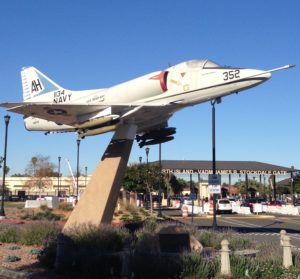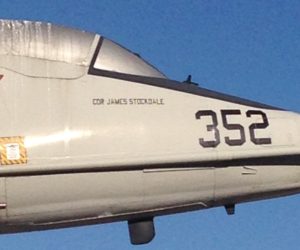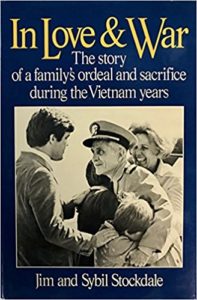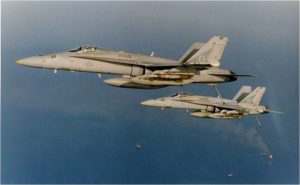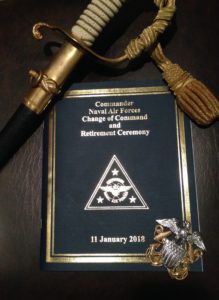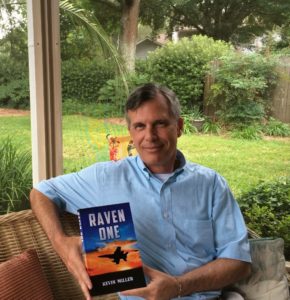In Love and War
This A-4E Skyhawk, on display outside the main gate at Naval Air Station North Island, is for the most part ignored by thousands of motorists each day. It is somewhat hidden by a tree, and of course each driver is digging in pockets for an ID card or drivers license to show the sentries as they approach the gate. Being an airplane junkie I glance at it most every time, having flown the two-seat training variant of the A-4 in flight school. A fun little jet, and I’ve bombed, strafed, shot rockets from it, trapped aboard USS Lexington in them off Pensacola, fought them in multi-plane engagements over east central Mississippi. One of the guys I fought in training was Major “Tamer” Amos, who had a successful career in the Marine Corps. As a Hornet pilot I fought quite a few “adversary” A-4’s, and one of those pilots was a cool guy named Lex Lefon. Roughly 100 TA-4J hours in my logbook prove that I was technically a Skyhawk pilot, but I would never claim that I flew the legendary Skyhawk in my career, because it would dishonor those who did, like the man who flew a Skyhawk into combat in September of 1965.
Commander Jim Stockdale was the Wing Commander, the “CAG,” when, flying a VA-163 Saints A-4E as replicated on this jet, he catapulted off USS Oriskany and headed west into North Vietnam. CAGs and squadron CO’s like Jeremiah Denton who led from the front were targeted by North Vietnamese gunners; anyplace in the skies of North Vietnam was dangerous, but flight lead losses were fearful, as they were for the eight-plus years of that conflict. Stockdale’s Skyhawk was hit and he ejected.
That morning in Oriskany’s wardroom he ate breakfast on china plates and white linen. For the next 7.5 years it was meager rations, solitary confinement, threadbare clothing and torture, brutal torture to include the dreaded ropes. The North Vietnamese were quick to identify and punish resisters, to break their will, and finding himself as the senior POW, Stockdale was targeted for more than his share of punishment. During this time – years of misery we cannot fathom – he led, from the front as Wing Commanders do, and organized the prisoners into a military organization that allowed them to not only draw support from one another but to serve with honor. And survive.
Vietnam was tearing the country apart, but in San Diego…and Lemoore, Oak Harbor, Jacksonville, Virginia Beach…families of POWs were hurting. Missing absent husbands and fathers was one thing, but not even knowing their fate or being denied even a letter was itself torture. Like her husband, Sybil Stockdale was a leader, and founded the National League of Families to call attention to the plight of the POWs and petition the government to lean on North Vietnam for humane treatment. Our government, and the Navy, consoled Mrs. Stockdale, saying they were doing everything they could and to please refrain from more public statements. She had none of it, and like her husband in captivity 8,000 miles away, she also led, working for the families to find resolution and pressure the enemy to improve the treatment of their loved ones.
At the time I was a boy living in San Diego’s University City; children of POWs with the names Burns, Shumaker and Rutledge were my schoolmates. We knew things were bad for POWs and many like my parents wore POW bracelets. “POWs never have a nice day” – remember that bumper sticker? To a large extent it was through the efforts of Sybil Stockdale, and others, leading from the front, in this case the home front.
We watched the POWs return home in 1973 and I get emotional thinking about it, seeing my schoolmates on TV run up to their fathers deplaning at Alameda or Miramar whom they had not seen in years. The family of one absent aviator who lived up the street didn’t have a joyous homecoming; their dad was Missing-in-Action, and decades later I read his remains were finally identified.
Stockdale was a legend I knew about as I entered flight school, as was Denton, John McCain (who also flew a Saint A-4E from Oriskany when he was downed), Bud Day, Leo Thorsness…names few Americans could remember by the early 80’s. But in 1992 America was reintroduced to retired Vice Admiral James Stockdale, the presidential running mate of billionaire Ross Perot. At the televised vice-presidential debate, standing alongside Dan Quayle and Al Gore, neither of whom was qualified to carry his helmet bag, he opened with this line to try to generate interest in this newcomer to national politics. “Who am I? Why am I here?”
The line backfired, and the white-haired grandfather, appearing confused and hard-of-hearing, was transformed into a national laughingstock, ridiculed for not being as sleek and smooth as Quayle or Gore. Maybe the Perot-Stockdale ticket cost Bush the 1992 election, but regardless, James Bond Stockdale retired from public life having tried to again serve the public through servant leadership. By the early 2000’s Alzheimer’s set in, and he succumbed in 2005 at the age of 81.
Once you go through the VADM James B. Stockdale Gate at North Island, the birthplace of naval aviation with piers and runways familiar to Commander Stockdale, you’ll see the Stockdale Training Building, and drive on Stockdale Boulevard. Go south along the bay, under the bridge to the 32nd Street Naval Station piers and you may see USS Stockdale, an Aegis guided-missile destroyer named for the Medal of Honor recipient, a warship bringing the Stockdale name back to the Western Pacific on each deployment. And there is the Stockdale Leadership Award, a coveted award one can receive only after nomination by ones peer group. Stockdale Award recipients are considered the best of the best, and good people.
Several years ago we were at a Change of Command ceremony aboard the carrier John C. Stennis at North Island, and during the hangar bay reception spied Sybil Stockdale. Elderly and suffering from Parkinsons, guests whispered in reverence that “Mrs. Stockdale is here,” and all were honored by her presence. There’s no escalator from the pier to the quarterdeck; she walked up the brow on her own power. The ladies present honored her with their gentle greetings, knowing exactly who she was and how special her being at the ceremony was for everyone there. The living legend passed away later that fall at the age of 90.
She and her beloved husband wrote a book about the Vietnam experience they shared half a world apart called In Love and War. It is a story of faith, in God and one another, of conviction, of devotion to duty, and courageous leadership in the face of enemy fire and US government bureaucracy. Published in 1984, it is only available “hard copy,” but it is a priceless story, a true love story, and one that is required reading for today’s generation of military couples. Anyone who has experienced a deployment homecoming can relate to this cover image, but imagine coming home after 7.5 years to a teenage son taller than you.
In Love and War by Jim and Sybil Stockdale is unforgettable. Do not pass it by.
Why We Lose, and What Can Be Done
This photograph, that I took 20 years ago over the North Arabian Gulf, is still a common sight. Those F/A-18C Hornets are still flown today and with similar weapons on the wings, and that Iranian oil-rig flare-stack down there is probably still burning as bright as it did in the 90’s when it served as a landmark for us. There is an American aircraft carrier nearby, such as there has been in the Gulf for almost every day of the past 20 years, and seven years before that.
I am not acquainted with Harlan Ullman, the author of the recently-released Anatomy of Failure: Why America Loses Every War it Starts, but was aware of him through his writings and guest appearances on cable news and CSPAN before I picked up his thought-provoking book. He is a naval officer by trade, a combat-experienced Vietnam swift-boat commander who went on to serve in “The Building” and defense think-tanks. He is a product of the Washington defense establishment, and is a sought-after commentator on defense issues. He has quite the pol-mil pedigree, and comes across as a serious guy who is speaks truth to power.
At its core, Anatomy is a study of the presidential administrations and the conflicts each has presided over since and including Vietnam. Though Ullman touches on the post-WWII world order, he cites military actions the United States has engaged in since he came of age in the 1960’s. It is not a record of success. While military men and women are justifiably proud of their service in combat, it is Washington, and primarily the White House, that almost every time manages to lose the peace. So then, why are we still patrolling the Arabian Gulf, and with airplanes and weapons that are 20-years old and older? Why is our annual defense budget some $700 billion with a new-normal of behind-schedule and over-budget acquisition programs? Why?
Ullman’s primary causal factor is that the occupants of the White House, even ones with résumés that say otherwise, are not well-versed (or just versed) in the realities of geopolitics. Unwilling to learn – they are already the Commander-in-Chief so why should they? – a succession of presidents and administrations, congresses, defense departments, diplomats and even uniformed commanders make blunder after blunder with lasting consequences in their wake. Groupthink takes hold, and I am reminded of my time in Washington after 9-11. By early 2002, going to war in Iraq to finish the job – regime change – was next; it was in the air. Look at the above photo; I knew the situation better than most citizens, had a sense of the risks involved, and supported the effort to change Iraqi governments. Ullman did not, and calls 2003 a catastrophe of the highest order. I would point to 2011 and the unilateral pull-out – abandonment – of Iraq on an artificial timeline, but serious political and diplomatic mistakes were made in 2003 and 2004 that made the situation much worse. Reasonable – and informed – citizens can disagree. This brings us back to Ullman’s first point. To have these educated conversations and debates, one must be educated. Short of sending every American to War College for an advanced degree in National Security Policy and Strategic Studies, self-study through reading is the answer.
Ullman’s book is not tearing up the charts on Kindle. While it is well-written and thorough, it, like most pol-mil literature, is dry and frankly over the heads of most Americans; not you, Dear Reader, but most and particularly our young Americans. If you admit to liking War College reading assignments (okay, okay, I read most of books assigned, but late at night…after the kids were asleep!) you’ll enjoy Ullman’s book. Alas, most of our citizenry has never heard of it and would not even crack it open were it handed to them. That’s fine…except every 2-4 years those same citizens wield a very powerful weapon – a vote.
If non-fiction books like Ullman’s are not going to be read by even a fraction of 1% of our population…how do we expect our population to know anything about the current challenges we face? We learn through stories. Movies are the easiest way, just sit back and watch, but even movies about real events can be quite flawed. Black Hawk Down and We Were Soldiers are exceptions. Movie fiction can be even worse, but there is a place for fiction.
Luke Ryan at SOFREP says it well that fiction allows the reader to get inside the character, multiple characters, on both sides of a conflict, and experience the drama and emotions of a fictional occurrence that could happen. To use hard-hitting and direct language to convey the feeling of being terrified or confused. Autobiographies do this well – hard to argue with a first-hand account – but fiction can take that to a higher level, and history is full of compelling stories that resonate with readers long after they’ve finished.
“Thank you for your service” rings hollow when the person saying it has no idea, zero, on how our men and women in uniform are deployed and what it is like for their families left behind. Especially today with instant global communications and 24-7 news. Our population is not being taught much of this in school – I assure you – and if they do not have a basic understanding of history and geography then geopolitical life is going to be harder for us as a society. Each of you have a favorite book, fiction or non-fiction, that encapsulates to you a story that every American should know. Give the gift of a book, as many do, to help friends and family understand.
Regrettably, Ullman discounted the 30-year “War on Drugs” as not worthy of his study. Those I know who have spent careers “fighting” it quip that our efforts such as they are only serve to prop up the price for traffickers. Books, more than movies, can deep-dive into philosophical questions of warfare and when to wage war, and when not to.
In Washington’s where-you-sit-is-where-you-stand political coloring (pretty sure I know where Ullman sits), Ullman does a good job calling them as he sees them, giving it to both parties who have much to be ashamed of. Our country and especially the active-duty military serving it deserves better, much better. It is not too much to ask of our elites in high-level defense, legislative, and diplomatic positions to read works such as his, and other works by well-known authors such as Stavridis and McMaster, to name a few. We should demand it of them. Popular market biographies of such as Powell, Cheney and Rumsfeld are also helpful to educate the public on how DoD functions and the realities of geopolitics, and there are plenty of authentic stories out there. Every American, and there is no excuse if you have a college education, should read at least one true-life account or authentic novel about our military in their lifetimes. That is supporting our troops, and that helps when making an educated vote every-other November.
And if you or your family cannot find the Arabian Gulf on a map, you have work to do. (I and others can help.)
Where Everybody Knows Your Name
People sometimes ask me if I miss flying. After all, who wouldn’t want to zip around at supersonic speeds and cloud-surf over the world’s oceans. I smile as I struggle to answer. What I should say is, “sure do!” or “only when I think about it,” which are boilerplate answers to the question. Another common question is, “what is it like to fly a fighter jet?” and as I’ve written before, how do you answer that one in a sentence or two? But back to the first question: Yes, I say, then add, as we aviators tend to do, the specifics. What I miss is naval aviation, the challenge and the camaraderie.
My wife and I were privileged to attend a Navy Change-of-Command and retirement ceremony last week in San Diego, where my friend VADM Mike “Shoe” Shoemaker relinquished command of Naval Air Forces to my friend VADM Chip “Bullet” Miller. It was held aboard Naval Air Station North Island, technically called Naval Base Coronado, but I hope the colloquial North Island lives on forever. It was held in a spacious aircraft hangar on the flight line not far from the I-Bar…more on that later.
We arrived the night before and saw friends. Actually we saw friends on the plane, friends of over 30 years, and there was not a moment during the next three days and nights that we were not among the types of friends you “grew up” with. We’ve been to each others homes, we’ve put each other up in our homes, and watched our kids play together and form their own life-long bonds. Some children we’ve known since infancy and pre-school attended, and some children were in dress blue uniforms.
On Thursday morning we rose early, and with the lobby mobbed with friends we hadn’t seen in some time there was no time to grab a bite to eat and still make the ceremony. Like Tailhook conventions, you make small-talk for 15-30 seconds before time or a coffee-line pulls you away. However, sometimes we had longer to really catch up, to understand what each other is doing, and to convey how much we mean to each other.
In this aviation community it is custom to begin these ceremonies at 1000am on a Thursday. Knowing it would be well attended we arrived early, to park the car, to find the assigned seats, and to socialize. I drove up with my parking pass displayed and identified myself. The Chief monitoring the parking lot asked me if I was family; well, I said, we were squadronmates and roommates. Close enough sir, park over there with the family!
We entered – joining a long line of friends – and got our seating assignment as the Navy Band played the familiar and stirring National Emblem. Row upon row – upon row – of seats were arranged with the dias platform at the hangar bay entrance, with naval static-display aircraft parked outside on the flight line. Business suits for men, most of us retired, and semi-formal business attire for the ladies, a smaller number also retired. It is our American social custom to shake hands, even after decades apart from someone you spent months living with. Our eyes meet and we move toward one another, shipmates who remember each other in our 20’s, squeezing one another’s hand in a manly grasp – and sometimes bringing that in for a closer hug signifying a shared experience and kinship. The ladies radiate dazzling smiles and share warm embraces – with everyone. It is like a family reunion. It is family, and we compliment each other and remark about the kids and the latest Facebook update until others grab our elbows as the process is repeated.
The ceremony begins on time, to the second. We stand as the official party is “piped” aboard through rows of side-boys as active duty salute. As Ruffles and Flourishes sounded I watched my friends in their Full Dress Blue regalia with pride, recalling flight school, and fun FA-18 hops over North Florida, and backyard bar-b-q’s with the kids running around. On the dias I know all the admirals, three of whom I have personal relationships.
The colors are paraded. All stand – not standing is unthinkable – and once the flag approaches we place our hands over our hearts while those in uniform salute. All one thousand guests are at attention, if they served in uniform or not, and all are still as the soloist sings the words to the song we all know by heart. During the last stanza I saw them over Point Loma, six dots signifying the familiar Delta formation, smoke-ON, and as the anthem ended the sound of 12 F404 engines increased to booming roar as the Blue Angels – their Hornets hook-down to make a statement – thundered over the hangar at 200 feet. Cool.
These ceremonies are pretty much cookie-cutter: A solemn invocation, guest speaker speech, medal award (Distinguished Service) to the outgoing commander followed by his farewell speech, the actual change of command, speech (short) by the incoming commander, benediction. This one was also a retirement for Shoe, hanging it up after almost 36 years of commissioned service. An American flag he had flown over his two carrier flagships and Naval Air Forces HQ was passed up the line as a poem was read. After it was placed in his hands, Shoe gave it to his mother in the front row, herself the widow of a veteran buried at Arlington. Moments later, with the crowd on their feet, Shoe, Peggy, and their girls were “piped over the side” between the side boys in naval tradition as all saluted Shoe, “going ashore” for the last time. At the end Peggy let out a whoop. Freedom!
There is a time in each ceremony, when the outgoing and incoming commander face each other, and using the words used on ship bridges as watches are changed every four hours all over the world, transfer authority and responsibility from one to the other. Shoe told Bullet he was prepared to be relieved as Commander, Naval Air Forces. Bullet saluted and said, “I relieve you, sir!” and Shoe answered, “I stand relieved.” At that moment Bullet took the conn, or in aviation terms, the lead, and both reported to Fleet Commander “Notso” that one was relieved and the other had assumed command and commensurate responsibilities even I can only imagine. In front of the assembled staff and 1,000 witnesses there was no doubt. We love our change-of-command ceremonies, and they are effective.
Once dismissed we fall into more handshakes and embraces with all around us, and congratulating Shoe and Bullet after standing in long lines to do so. Outside on the sun-splashed flight line the “petting zoo” of fleet aircraft await guests to get a closer look, and a catering tent forms a line that begins near the hangar. The legends mingle about, current rising stars chat in groups, and we see friends and shipmates we note to find later; sadly, I missed chances with a few in the giant crowd.
That afternoon we gathered on the rooftop with bottles and cups – not that we are glorifying anything, mind you – and reflected on the ceremony and caught up with those we had not yet had a chance. A loud, booming, deafening sound erupted next to us and soon a JSF appeared behind our building as it took off to the west. It turned hard left and departed to the south along Point Loma; several in our group knew the pilot flying it. That afternoon two Super Hornets came into the break and landed, with us has-beens watching the entire time. The next morning I ran into one of the lieutenants that flew one, one whom I’ve met before.
The next two days and nights were filled with social events; a huge reception at the Island Club, golf (Friday and Saturday, with a few legit par holes!), side trips to Coronado and a gathering at the famous I-Bar. Legend has it you’ll always see an old friend there each time you walk in, and I’ve found that to be pretty much true over the years I’ve visited, in a flight suit or civvies. Like the weekend, it is where everybody knows your name. (Don’t touch the model airplanes, and don’t put your phone on the bar!)
We went to mass Sunday morning to give thanks before lugging our stuff to Lindbergh for the flight home. Just to be there at such an important ceremony, to see so many of our closest friends, to enjoy the balmy SoCal sun while the rest of the US was scraping ice off windshields (we should live here!), and spend time smiling and laughing and enjoying each other’s familiar company – it is priceless.
While the ages of those attending ranged from mid-90’s to teen, most of our group that served with Shoe and Bullet are around 60, plus or minus. The ladies are aging gracefully and us guys are grayer, heavier, balder…but all of us wiser, knowing how special moments like these are. We look forward to the next time, to solve the world’s problems, to tell the same and sometimes new sea stories, to get the latest on the kids, and inquire about elderly parents who need our care now. To laugh and smile.
The challenge of naval aviation such as leading a complex airborne evolution is long past. Thankfully, my memories are rich. But the camaraderie I experienced remains, and we look forward to the next gathering in the coming months, or years, among familiar friends, as familiar as family, and not taking any of it for granted.
My How-to of Independent Publishing
So, you want to publish a book. Given that you’ve written one, that is an admirable goal. You should share with friends and family – and thousands of strangers – what you’ve created. Why not? We are called to share our talents, and to help where we can.
In recent months several people have asked me about the process of book publishing in today’s new normal of ebooks, print-on-demand, and audiobooks. After rejections from what I’ll call “New York,” I found – through my network – independent publishing. As I wrote in a previous blog post, the dominant e-reader Kindle has revolutionized publishing like nothing since the Gutenberg Press, and fellow author and veteran Jeff Edwards of Braveship Books, who is an award-winning writer of remarkable success, walked me through it. Here are the steps I’ve used in my journey as an author/entrepreneur.
- Write, re-write, repeat Whew! You finished your book. Send it to the editor?…not so fast. Print it out – on paper – then take a pen…and make corrections. You’ll see things, and fix things, and re-word things, and correcting it out on paper allows for “fresh” eyes and quick edits/notes. Stephen King gives himself several weeks after writing a passage before coming back to it and editing in this way. Cut, sand, and polish, polish, polish, polish. Between rejection letters I did this for months and it paid off. James Webb said he re-wrote Fields of Fire six times before it was ready, and knew he had a fine piece of literature when he did. You need to have that feeling too, to know deep down that, “this is good.”
- Collaborative Editing My superb editor, Linda Wasserman, would edit a chunk of the manuscript (say 2,000 words), send me the edited chunk via email, and then we’d meet on the phone to discuss the edits. Every paragraph, every sentence, every word. Linda challenges me to justify my word choices, and often has me read a sentence or paragraph. This is a fascinating process, and it allows us – yes, us – to make a good passage better. Linda suggests, but she also allows me the author to have 51% of the vote when we have disagreements. There is content editing (storyline, prose) and copy editing (spelling, punctuation). Both are important, and Linda does both, she’s a gem. Linda compiles all the edits into a working rough…this process takes many months (over six months) of detailed effort, but worth every moment spent on it. (And by the way, it’s words. People ask me how many pages my novels run. Pages are font and format dependent. A word, on the other hand, is a word.)
- Beta Readers We remember the teachers (instructors, flight evaluators) who pushed us. You want your beta readers, readers who are going to give you a “sanity check,” to push you. While there are always exceptions, your loving family members are probably not good beta readers. You want friends/professional associates you can trust to give you that constructive criticism we all crave. In my techno-thriller genre – with readers who cannot wait to catch errors – I need the beta reader to catch them first, but also to suggest alternate story outcomes and question the techno-details. Editor or beta reader – which comes first? Not critical, and they can occur simultaneously. Once edited, if a beta reader (or me) makes major changes, I’ll use my judgment if the changes need Linda’s eye. For the editor and beta reader, my job is to get them the best possible manuscript from which to work. Polish, polish, polish.
- Cover Design We’re in the home stretch now, about a month from publishing, and the book needs a cover. This is also the subject of a previous blog post, but suffice to say I used 99Designs. I held a “contest” to solicit cover designers from around the world, giving them a basic run-down of my novel and general ideas for a cover. Off they go, and they design covers for Kindle, Trade-paperback, and audiobook; all different. They are pros, and they know to allow space for the ISBN bar code, the spine, back-cover metadata, etc. 99Designs allows you – and people you invite – to rate covers and work direct with the designers for changes. Another fascinating process, and in the end you declare a winner, 99Designs releases the prize money to the designer and you, the author, have rights to the cover you purchased. This process took me 2-3 weeks each time…the final decision is tough.
- Metadata Of warfare, Clausewitz said “…everything is simple, but even the simplest things are difficult.” Metadata is the “stuff” in the book that is not part of the manuscript. The author bio and back cover blurb are two examples. (The acknowledgments section is part of the manuscript.) Like everything, this needs some thought to make the most of each word in this precious space. Have them ready for when you enter them; more on that in a minute.
- Formatting There are two types of formatting; PDF and MOBI. A trade-paperback, an actual book you can hold, uses the PDF format. Most of you could plow through that, right? Well, a professionally done book requires the right number of pages, and logical page breaks, etc. Your first page needs to be blank – because the inside front cover is blank, right? For Kindle, a MOBI zip-drive is required. Jeff and Braveship do this for me, after we’ve both given the manuscript a final scrub, and when complete I have the formatted files.
- Uploading into CreateSpace and KDP This takes me about 45-60 minutes each on the CreateSpace and Kindle Direct Publishing accounts I created. Both methods have a step-by-step process that guides the author. Enter your ISBN, enter your genre, enter your cover. For your trade paperback, do you prefer white or cream colored paper? I guessed “white?” until Jeff said no – cream is easier to read from. Cream it is, no argument. You enter your metadata and answer various questions in the process until you come to the last box: Publish your book. Once you click on that, it is on Kindle or available on CreateSpace within 24 hours, and all of this is at no cost to you. For CreateSpace, they ask if you want an electronic or trade-paperback copy to give one last look. I choose the hard copy which shows up at my door days later. Mistakes that are found are corrected, reformatted, and re-entered. Once complete, the book is “live” with a publishing date.
- Promoting After I published Raven One, Linda told me I just signed up for a new “job.” For those of us who approach this from a professional standpoint, promoting and marketing is an effort and there are many great books and resources on how to do this. Perhaps a future blog post, and I’m still learning. Frankly, it was through my promotion efforts that Tantor Media found me and offered an audiobook contract. Before that of course, the manuscript was written, cut, sanded, and polished in careful detail.
For less than five dollars people can have my novels delivered to their Kindle App, and for not much more to their Audible App. Less than 5% of my readers prefer a good old-fashioned book to hold, and CreateSpace (which has several print factories in the United States) prints one book (or whatever ordered) and ships it to the reader’s door. The photo below is of me three years ago with the proof copy of Raven One, which now has a new and improved cover. Thousands of hours of effort went into that, and in my own “new normal” of diverse business endeavors the effort is well worth it. If you’ve got a book in you, publish it. It has never been easier.
